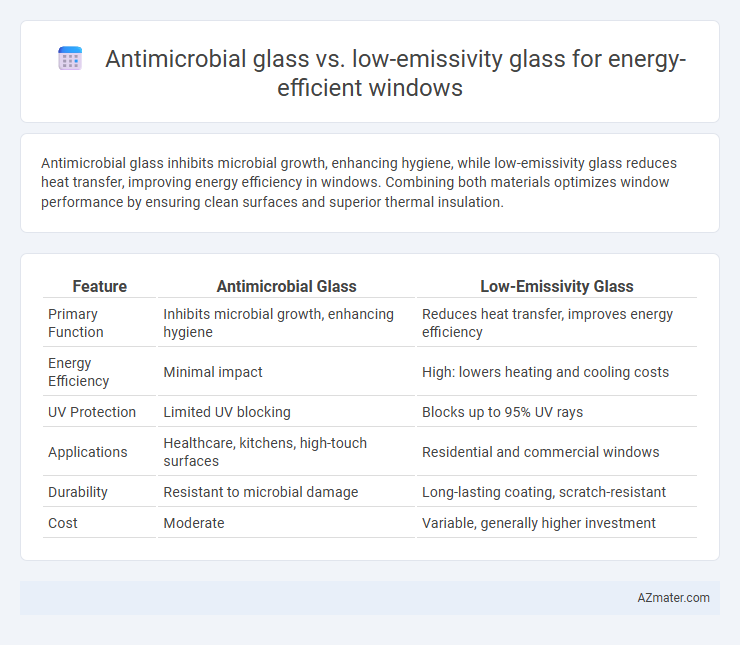Antimicrobial glass inhibits microbial growth, enhancing hygiene, while low-emissivity glass reduces heat transfer, improving energy efficiency in windows. Combining both materials optimizes window performance by ensuring clean surfaces and superior thermal insulation.
Table of Comparison
| Feature | Antimicrobial Glass | Low-Emissivity Glass |
|---|---|---|
| Primary Function | Inhibits microbial growth, enhancing hygiene | Reduces heat transfer, improves energy efficiency |
| Energy Efficiency | Minimal impact | High: lowers heating and cooling costs |
| UV Protection | Limited UV blocking | Blocks up to 95% UV rays |
| Applications | Healthcare, kitchens, high-touch surfaces | Residential and commercial windows |
| Durability | Resistant to microbial damage | Long-lasting coating, scratch-resistant |
| Cost | Moderate | Variable, generally higher investment |
Introduction to Energy-Efficient Window Technologies
Energy-efficient window technologies integrate materials such as antimicrobial glass and low-emissivity (Low-E) glass to enhance building performance and occupant health. Antimicrobial glass inhibits bacterial growth on window surfaces, contributing to cleaner indoor environments, while Low-E glass minimizes heat transfer by reflecting infrared radiation, significantly improving thermal insulation. Combining these technologies supports sustainable building practices by reducing energy consumption and enhancing indoor air quality.
What is Antimicrobial Glass?
Antimicrobial glass is specially treated to inhibit the growth of bacteria, viruses, and fungi on its surface, enhancing hygiene and safety in energy-efficient windows. It incorporates antimicrobial agents like silver ions or copper nanoparticles that disrupt microbial cell functions without compromising the glass's thermal insulation properties. This glass type complements Low-emissivity (Low-E) glass by maintaining cleanliness while optimizing energy performance through reduced heat transfer and improved solar control.
Key Properties of Low-Emissivity (Low-E) Glass
Low-Emissivity (Low-E) glass features a microscopically thin coating that significantly reduces infrared and ultraviolet light transmission without compromising visible light, enhancing thermal insulation and energy efficiency in windows. Its key properties include high solar heat gain coefficient (SHGC) control, low U-value for superior insulation, and prevention of heat loss, which contributes to reduced heating and cooling costs. Unlike antimicrobial glass that focuses on inhibiting microbial growth, Low-E glass primarily optimizes energy performance by reflecting radiant heat and improving interior comfort in energy-efficient buildings.
Mechanisms of Action: Antimicrobial vs. Low-E Coatings
Antimicrobial glass incorporates coatings embedded with agents such as silver ions or copper nanoparticles that actively disrupt microbial cell membranes, inhibiting bacterial and viral growth on window surfaces. Low-emissivity (Low-E) glass features microscopically thin metallic layers designed to reflect infrared radiation, minimizing heat transfer and enhancing thermal insulation in energy-efficient windows. These distinct mechanisms--biocidal action in antimicrobial coatings versus spectral selectivity in Low-E coatings--address different performance criteria critical for sustainable building environments.
Energy Efficiency Benefits: Antimicrobial Glass Compared
Antimicrobial glass primarily enhances indoor hygiene by inhibiting microbial growth on window surfaces, but its direct impact on energy efficiency is limited compared to low-emissivity (Low-E) glass. Low-E glass significantly reduces heat transfer by reflecting infrared radiation, thereby improving insulation and lowering heating and cooling energy consumption in buildings. Energy-efficient windows utilizing Low-E coatings optimize thermal performance and contribute more effectively to reducing utility costs and carbon emissions than antimicrobial glass technologies.
Energy Performance: Low-Emissivity Glass in Focus
Low-emissivity (Low-E) glass significantly enhances energy performance by minimizing infrared and ultraviolet light transmission while maximizing visible light, reducing heat loss through windows by up to 30-50%. Unlike antimicrobial glass, which primarily targets surface hygiene without impacting thermal insulation, Low-E glass incorporates microscopically thin metallic coatings that reflect heat back into the room during winter and repel solar heat in summer. This thermal regulation lowers energy consumption for heating and cooling, making Low-E glass a superior choice for energy-efficient window solutions focused on reducing utility costs and carbon footprint.
Health and Safety Considerations
Antimicrobial glass incorporates advanced coatings that inhibit the growth of bacteria and viruses on window surfaces, enhancing indoor air quality and reducing health risks in residential and commercial buildings. Low-emissivity (Low-E) glass primarily improves energy efficiency by minimizing heat transfer, but it lacks inherent antimicrobial properties, potentially allowing microbial buildup over time without regular cleaning. Choosing antimicrobial glass for energy-efficient windows ensures health and safety by combining pathogen control with thermal performance, offering a safer indoor environment compared to standard Low-E glass.
Cost and Installation Differences
Antimicrobial glass typically incurs higher costs due to its specialized coatings designed to inhibit microbial growth, whereas Low-emissivity (Low-E) glass is generally more affordable, focusing on thermal insulation to reduce energy consumption. Installation of antimicrobial glass may require extra handling and maintenance precautions to preserve its surface efficacy, while Low-E glass installation follows standard window glazing procedures without additional complexity. Cost-efficient energy savings from Low-E glass often offset upfront expenses faster, whereas antimicrobial glass adds value primarily in environments demanding hygiene control rather than energy efficiency.
Ideal Applications for Each Glass Type
Antimicrobial glass is ideal for healthcare facilities, schools, and food processing plants where hygiene and surface cleanliness are critical to prevent the spread of pathogens. Low-emissivity (Low-E) glass is best suited for residential and commercial buildings aiming to enhance energy efficiency through superior insulation, reducing heat transfer while allowing natural light. Combining both technologies can provide dual benefits in environments that require both energy savings and antimicrobial properties.
Future Trends in Smart Window Technologies
Antimicrobial glass incorporates silver ions or copper compounds to prevent bacterial growth, improving hygiene in smart windows, while low-emissivity (Low-E) glass enhances energy efficiency by reducing infrared and ultraviolet light transmission, maintaining indoor temperatures. Future trends in smart window technologies emphasize integrating Low-E coatings with electrochromic or thermochromic layers for dynamic control of light and heat, alongside antimicrobial properties to promote health in commercial and residential buildings. Advances in nanotechnology and IoT connectivity are driving the development of multifunctional smart windows that combine energy savings, environmental sustainability, and occupant well-being.

Infographic: Antimicrobial glass vs Low-emissivity glass for Energy-efficient window
 azmater.com
azmater.com